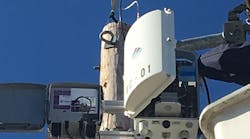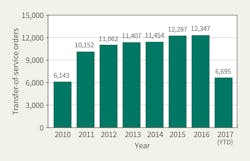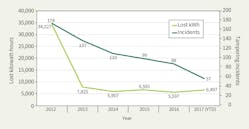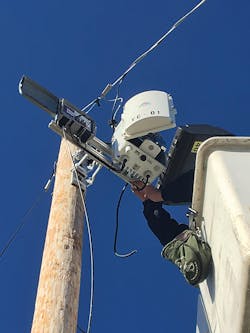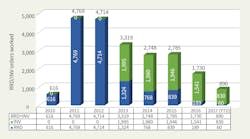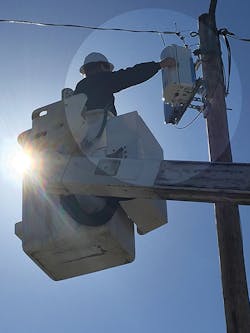Modern utilities are challenged to do more with less. Today, utilities must meet the ever-growing expectations of consumers while maintaining or reducing operational costs and, most importantly, keeping the lights on, despite heavy electricity demand. To support each of these competing priorities, many utilities are turning to smart meters and advanced metering infrastructure (AMI) for additional help.
BrightRidge — a public, not-for-profit electric utility located in Tennessee, U.S. — is one such AMI-enabled utility. BrightRidge decided to install an AMI system in 2010 to meet a requirement to support time-of-use rates. The utility performed an economic assessment to evaluate the performance of its AMI system after five years of installation. Looking at data from 2012 to 2017, BrightRidge leadership found the AMI system avoided more than 20,000 truck rolls and brought in more than US$1 million in translated savings each year. On top of these quantitative benefits, the utility also saw greater satisfaction in both the employee and customer experience.
AMI System
To best meet the utility’s geographically diverse service territory, BrightRidge chose the Tantalus Utility Network (TUNet) AMI system, from Tantalus Systems Corp., mainly because of its flexible radio-frequency communications and Tantalus’ ability to create a customized network solution for BrightRidge’s needs. The utility currently uses a combination of the 900-MHz frequency for the local area communications and Tantalus’ high-range 220-MHz network for backhaul through the rural and mountainous areas. The AMI system deployment began in 2010 and was completed in 2012, along with the implementation of a new meter data management system (MDMS). Later, BrightRidge also integrated fiber-based connectivity into its AMI network.
When BrightRidge deployed the TUNet AMI system, one immediate benefit it gained was the streamlined handling of transfer-of-service (TOS) orders. These orders are common in rentals and occur when customers move into and out of their homes. In a typical year, this happens more than 10,000 times in BrightRidge’s service territory, and that number is increasing because of new apartments built in recent years.
Before AMI, TOS orders were handled manually, by creating a printed paper order, which was handed over to the field service team. The team would meet at the beginning of the day to divide orders internally and go out into the field to collect data. This was a very costly process because of both the high amount of site visits and manual administrative work required. With AMI, these costly site visits were eliminated completely. Between 2012 and 2017, BrightRidge filled more than 65,000 TOS orders electronically, saving 65,000 site visits and approximately $3.25 million in a little over five years.
Electronic TOS orders have transformed BrightRidge’s business. With AMI, the utility’s widespread workforce has access to near-real-time data, which has eliminated the need to create orders manually and wait for replies from field teams. Teams no longer need to complete an on-demand meter read; billing personnel can simply take the last midnight reading from the MDMS. Using the midnight reading provides a clean and consistent point of transition for customers who are moving.
The benefits of avoided site visits are doubled with service disconnect and reconnect orders. Using strategically deployed meters with integrated service disconnect switches, the AMI system can issue commands to disconnect and reconnect the service remotely and avoid two separate site visits for each disconnect-reconnect combination. To date, BrightRidge has executed 14,871 remote disconnects and reconnects since 2014. All of these would have required site visits before the AMI deployment. Today, BrightRidge can handle about 30% of disconnect and reconnect orders remotely despite having meters with this capability for only a small fraction of customers. That number grows each year as BrightRidge deploys more meters with these remote capabilities.
Customer Reaction
The number of disconnect and reconnect site visits BrightRidge has avoided may be higher than those recorded because of a change in customer behavior related to the AMI rollout. Customers have learned BrightRidge can now disconnect their electricity without a site visit and are more likely to pay their bill. AMI implementation has been correlated with a change in customer behavior, and BrightRidge leadership believes the length of time a customer is disconnected may have gone down, as well. Because AMI is installed locally, it is not uncommon for BrightRidge to send in a disconnection order and then quickly receive payment from a customer before the order is completed.
AMI cuts the delay out of utility operations and increases customer satisfaction with faster reconnection services. Disconnected customers who can bring their accounts current used to have to wait until a technician could come out and reconnect them. BrightRidge provides 24/7 reconnection service, but for a customer without power, any delay can be frustrating. Now BrightRidge can reward customers by reconnecting them almost immediately to create a more pleasant customer experience and reduce off-hours site visits by technicians.
Theft Issues
AMI also can now detect current diversion easily — a benefit that has helped BrightRidge proactively detect and prevent meter tampering. In 2012, 174 incidents were detected, with a total of 34,227 diverted kilowatt-hours. Since then, the utility has moved beyond tamper detection to tamper prevention. Today, the number of incidents is down to about half those experienced in 2012. Having dealt with the biggest offenders first, the utility has seen a reduction in diverted kilowatt-hours of more than 80%. BrightRidge leadership believes this is a result of customer education. Local customers have learned BrightRidge’s meters are smart now and the utility follows up 100% on alarms. The utility takes energy diversion seriously and applies fees for tampering with a meter.
Another example of detection turning into prevention is a decrease in the investigate-still-off orders throughout BrightRidge’s territory. An investigate-still-off order is generated when a smart meter shows kilowatt-hour consumption from a meter is in an inactive and installed state. The AMI system sends meter interval data to the head-end every hour and quickly identifies anomalies in inactive meters.
When a meter anomaly is detected, a site investigation is triggered automatically. Sometimes the anomaly is caused by faulty equipment, which now can be detected and corrected easily, but sometimes it is due to tampering. Today, investigate-still-off orders are almost nonexistent, saving more than 1000 site visits per year. This is because of a combination of on-request reads, remote service disconnects and customer education. Word has spread: If a customer connects his or her own service, it will not take long for BrightRidge to find out and act.
Investigate Anomalies
BrightRidge is saving an additional 3000 site visits per year through a reduction in reread-investigate orders. A reread-investigate order is the result of a meter reading that shows some anomaly, like a sudden jump in consumption that is radically different from the customer’s normal usage pattern. When this happens, an employee is dispatched to the customer’s site to check the meter.
Reread-investigate orders still require a site visit, but the number of these orders has dropped substantially through daily variance reporting and the ability to complete on-request reads remotely through the AMI system. On the rare occasions when a site visit is required, it now often leads to the discovery of a deeper issue, like an equipment failure or a tampering attempt. Before AMI, these anomalies were harder to identify and diagnose for customers.
The biggest change AMI has enabled is rapid and efficient anomaly detection and resolution. The AMI system can detect changes quickly in a consumer’s energy consumption from its average usage pattern. These changes previously would be reflected only in a customer’s monthly bills and could take three billing cycles for a customer to notice. Unsure of what caused the large bill, the customer often would ask for costly and ineffective meter tests. Now BrightRidge has a better understanding of customers’ loads as well as in-the-moment and historical interval data. It can pinpoint and investigate past as well as current energy deviations better — and, more importantly, determine what caused them. The utility also can act proactively to notify customers of any large energy changes ahead of receiving a bill.
It Adds Up
TOS orders, disconnects and reconnects, reread-investigate orders and investigate-still-off orders add up to about 20,000 avoided site visits per year with TUNet AMI, translating to an estimated $1 million in savings annually. In addition to these easily quantified savings, BrightRidge also benefits from streamlined back-office operations and business process transformations. With AMI, BrightRidge has been able to automate simple tasks and reduce the number of necessary in-person site visits. Utility employees now can learn to perform complex and valuable maintenance tasks, including splicing fiber, installing wireless Internet service, and performing maintenance on AMI sites and water heaters.
Another big success factor for BrightRidge has been its Take a Load Off (TALO) program. Launched in 2013, this program has been a real win-win for BrightRidge and its customers. As a member of the Tennessee Valley Authority (TVA), BrightRidge pays a monthly peak demand charge to TVA based on the highest one-hour system demand for electricity. Through the TALO program, BrightRidge can reduce this monthly charge while also helping customers to make heating their water more affordable.
BrightRidge offers customers a rebate and enrollment in a water heater maintenance program in return for allowing BrightRidge to install a load control switch on their water heater. Because BrightRidge uses Tantalus load management devices that communicate on TUNet’s AMI network, the TALO program was rolled out with little or no additional communication infrastructure. This system enables BrightRidge to leverage AMI to shed load when a demand peak is expected and reduce the associated TVA charge. The demand the utility can control — and shed when needed — now represents 2.5 MW and 5000 TALO installations.
The initiative has provided a net savings of more than $200,000 per year, with expected cumulative savings of $7.8 million through 2031. Customers on the program do not notice any difference in their hot water availability, and they love the worry-free maintenance performed by trusted BrightRidge AMI employees.
TUNet’s real-time outage and restoration reporting capability helped BrightRidge first to identify and then to improve reliability indices. A measure of the average amount of downtime per customer in a given year, the system average interruption duration index (SAIDI) dropped 35%, from 64.4 minutes in 2014 to 41.4 minutes in 2017. The average number of outages per customer in the year, system average interruption frequency index (SAIFI) improved from 0.678 to 0.554 over that same period, a reduction of almost 20%. The average time it takes to restore an outage, the customer average interruption duration index (CAIDI) dropped more than 20%, from 94.96 minutes to 74.85 minutes. With the help of Tantalus AMI technology, BrightRidge now is doing a better job of keeping the lights on for customers and quickly recovering when outages occur.
The Transformation
AMI has increased productivity and quality of life at BrightRidge. The utility now has fewer and shorter outages as well as heightened customer satisfaction by taking care of problems before its customers even know about them. A $1.2 million per year cost savings plus a greater than 80% reduction in diverted kilowatt-hours is impressive, but BrightRidge believes the direct financial savings are just the tip of the iceberg when it comes to the benefits it has realized from the Tantalus AMI system.
BrightRidge leadership believes every public utility owes it to the community it serves to take advantage of these benefits. AMI has transformed BrightRidge’s business. It is not a question of whether a utility can afford to implement AMI, but rather it is an understanding that modern utilities cannot afford not to install it. ♦
Eric Egan is chief data officer for BrightRidge, an energy authority serving more than 77,000 electric customers in eastern Tennessee. He has been with the utility for eight years and provides leadership for the BrightRidge advanced metering infrastructure and billing departments.
